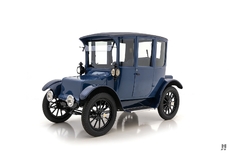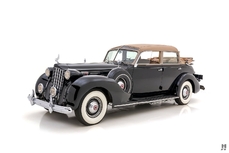Apollo 5000 GT 1964
Allgemeine Beschreibung :
In the early 1960s, an aspiring young American engineer named Milt Brown dreamed of designing and building an American sports car to compete with the likes of Aston Martin, Maserati or Ferrari. There has never been a shortage of enthusiasts sharing the same dream; however, Milt Brown was among a select few to turn his into reality. Putting his engineering skills to good use, he designed a tubular, coil-sprung chassis from scratch, while his friend Ron Plescia, himself a graduate of Pasadena’s elite Art Center College of Design, did the initial styling work for the body. For the engine, Milt instead turned to Buick, for their new all-aluminum 215 cubic-inch V8, which was compact, lightweight, and powerful. He hoped to sell the car through select Buick dealers, but the deal never worked out, perhaps because GM wanted to protect the Corvette.
With the design settled, he partnered with Frank Reisner of Carrozzeria Intermeccanica in Turin, Italy. Intermeccanica had a solid reputation for high-quality tuning parts and racing cars. At Reisner’s suggestion, the famous Italian designer Franco Scaglione refined the design, lending the project serious credibility. Scaglione added rear quarter windows, reworked the tail to taper subtly, and shortened the nose to create a beautiful and balanced fastback coupe. Intermeccanica handled the construction of the chassis and body, then shipped the trimmed and painted cars to Oakland, California, to install the running gear.
On its debut, Road & Track lavished praise on the new Apollo GT for its balanced handling, surprising comfort, and exciting performance. Despite the very favorable press, the project faltered due to the costly assembly process and lack of a suitable dealer network. The more powerful, 4.9-liter Buick Skylark-powered 5000 GT was a welcome addition, but problems were too much to overcome, and Brown soon lost control of the project. The remaining cars were assembled in Texas and sold as the Vetta Ventura, but in the end, approximately 88 examples of the 3500 GT, 5000 GT, Apollo Spyder, and Vetta Ventura were produced in total.
Offered here is chassis number 1074, the second-to-last coupe produced, and one of a handful to feature the desirable 4.9-liter Buick Skylark V8. This fabulous example is one of only two cars finished by Intermeccanica in British Racing Green and it has covered just under 4,000 miles from new. It boasts a well-documented ownership history, including a period when it belonged to Apollo creator Milt Brown. In a 2004 letter, Milt Brown attested to the car’s exceptional originality and mileage. According to Brown, 1074 was the best-preserved Apollo in the world, having spent 35 years carefully stored in a dry environment in Southern California, and during the time of his ownership, it showed fewer than 1,300 miles, which is noted on a copy of the California title in his name.
The Apollo later traded hands to a collector who commissioned a high-quality respray in the original shade of British Racing Green. Great care was taken to preserve the correct Borrani wire wheels, exterior chrome trim, and the delicate aluminum alloy “eggcrate” grille. The paintwork is finished to a high standard, displaying smooth, even finishing, and very straight coachwork. This dark green shade suits the Apollo’s proportions exceptionally and highlights the lovely design and beautifully crafted coachwork.
Apollo GTs are renowned for their comfort and accommodating driving position. Even taller drivers would feel great after a day’s touring behind the wheel, thanks to the generous headroom, plenty of legroom, and supportive seats. The black leather seat upholstery has been restored, while the doors panels, dash covering, carpets, and interior fittings are all original. It includes the rare factory-fitted 3-spoke steering wheel, an original array of Jaeger dials, and correct switches all in superb order. The intricately engraved ashtray is similar to those seen on many coachbuilt Italian cars of the period, and it remains crisp and like-new, down to the tiny Apollo emblem. The boot houses the original spare wheel and Pirelli Cinturato tire.
Buick’s powerful 300 cubic-inch V8 (shared with the Skylark) sits under the bonnet, dressed with a chrome air cleaner and Apollo-badged finned alloy valve covers. The engine bay and undercarriage are honest and tidy, reflective of the car’s preserved nature, while also showing signs of maintenance and care to ensure it remains in top running order. The balanced chassis, robust American V8, and remarkably comfortable interior make the Apollo one of the best-kept secrets for historic road rallies and touring events.
While in the care of previous owners, chassis 1074 appeared at the 2010 Milwaukee Concours, and earned an AACA National First Prize at the 2012 Cedar Rapid, IA meet. It remains in superb condition, suitable for preservation class concours events or driving enjoyment. With provenance that includes ownership by its creator, Milt Brown, this genuinely remarkable Apollo 5000 GT will be a welcome addition to the most exclusive collections.
Offers welcome and trades considered
https://hymanltd.com/vehicles/6726
1964 Apollo 5000 GT is listed verkauft on ClassicDigest in St. Louis by Mark Hyman for $225000.
Fakten der Auto
Karosserietyp : Auto Marke : Apollo Modell : 5000 GT Hubraum : 0.0 Modelljahr : 1964 Lage : Missouri
Verkauft
Angaben Zum Verkäufer
Verkauft
Other cars listed for sale by this dealer
über Apollo
Der Apollo ist ein interessantes italienisch-amerikanisches GT-Auto, das in den 1960er Jahren hergestellt wurde. Es wurde entwickelt, um eine Kombination aus amerikanischer Kraft und italienischem Stil zu bieten. Über seinen Status als „großer“ oder „Ferrari des armen Mannes“ gehen die Meinungen unter Automobilenthusiasten auseinander. Hier sind einige Punkte, die Sie beachten sollten:1. Design und Styling: Der Apollo hatte ein elegantes und attraktives Design, das vom italienischen Design beeinflusst war. Er zeichnete sich durch ein niedriges Profil, elegante Linien und häufig durch kraftvolle amerikanische V8-Motoren aus. Das Design zielte darauf ab, die Essenz europäischer Hochleistungssportwagen einzufangen.
2. Leistung: Die Leistung des Apollo war dank seiner leistungsstarken Motoren bemerkenswert. Typischerweise war er mit amerikanischen V8-Motoren von Firmen wie Buick und Oldsmobile ausgestattet, die über beachtliche PS- und Drehmomentwerte verfügten. Dadurch konnte der Apollo eine starke Beschleunigung und beeindruckende Höchstgeschwindigkeiten erzielen.
3. Verarbeitungsqualität und Entwicklung: Der Apollo wurde in begrenzten Stückzahlen hergestellt und es gab einige Herausforderungen hinsichtlich der Verarbeitungsqualität und Entwicklung. Das Unternehmen hatte finanzielle Schwierigkeiten und verfügte nicht über die Ressourcen etablierter Hersteller wie Ferrari. Infolgedessen hatten einige Besitzer Probleme mit der Zuverlässigkeit und die allgemeine Verfeinerung des Wagens konnte im Vergleich zu seinen Konkurrenten als unterentwickelt angesehen werden.
4. Potenzial mit besseren Ressourcen: Es ist plausibel anzunehmen, dass der Apollo mit besseren Ressourcen noch größere Erfolge hätte erzielen können. Mehr Investitionen in Entwicklung, Technik und Produktion hätten die Zuverlässigkeits- und Verarbeitungsqualitätsprobleme lösen und möglicherweise zu einem raffinierteren und wettbewerbsfähigeren Sportwagen führen können.
Letztendlich ist es subjektiv, ob der Apollo als „großer“ oder „Ferrari des armen Mannes“ gilt. Es hatte seinen ganz eigenen Charme und seine ganz eigenen Leistungsmerkmale. Auch wenn er vielleicht nicht den gleichen Bekanntheitsgrad oder das gleiche Ansehen wie Ferrari erlangt hat, nimmt er dennoch einen Platz in der Automobilgeschichte als interessantes und unverwechselbares GT-Auto ein, das italienischen Stil mit amerikanischer Kraft verband.
Der Apollo wurde während seiner Produktionszeit in einigen verschiedenen Modellen hergestellt. Hier sind einige wichtige Modelle, Spezifikationen und geschätzte Produktionszahlen für den Apollo GT:
1. Apollo 3500 GT:
- Motor: 3,5-Liter-V8-Motor von Buick
- Leistung: Ungefähr 200 PS
- Getriebe: 4-Gang-Schaltgetriebe oder optional Automatik
- Produktionszahlen: Zwischen 1962 und 1964 wurden rund 88 Apollo 3500 GT produziert.
2. Apollo 5000 GT:
- Motor: 5,0-Liter-V8-Motor von Buick
- Leistung: Ungefähr 300 PS
- Getriebe: 3-Gang-Automatik oder optional 4-Gang-Schaltgetriebe
- Produktionszahlen: Zwischen 1964 und 1965 wurden etwa 90 Apollo 5000 GT produziert.
3. Apollo 3500 GT Spider:
- Motor: 3,5-Liter-V8-Motor von Buick
- Leistung: Ungefähr 200 PS
- Getriebe: 4-Gang-Schaltgetriebe oder optional Automatik
- Produktionszahlen: Zwischen 1963 und 1964 wurden etwa 11 Apollo 3500 GT Spider produziert.
4. Apollo 5000 GT Spider:
- Motor: 5,0-Liter-V8-Motor von Buick
- Leistung: Ungefähr 300 PS
- Getriebe: 3-Gang-Automatik oder optional 4-Gang-Schaltgetriebe
- Produktionszahlen: Es wurden nur wenige Apollo 5000 GT Spider produziert, daher ist die genaue Zahl ungewiss, sie wird jedoch auf einstellige Zahlen geschätzt.
Insgesamt sind die Gesamtproduktionszahlen des Apollo GT relativ gering, mit insgesamt etwa 200–250 produzierten Fahrzeugen aller Modelle. Die genauen Produktionszahlen können variieren, und es ist erwähnenswert, dass der Apollo während seines Produktionslaufs verschiedene Eigentümer- und Produktionswechsel durchlief, die sich möglicherweise auf die Gesamtzahlen ausgewirkt haben. Diese begrenzten Produktionszahlen tragen dazu bei, dass der Apollo GT heute selten und sammelbar ist.




















